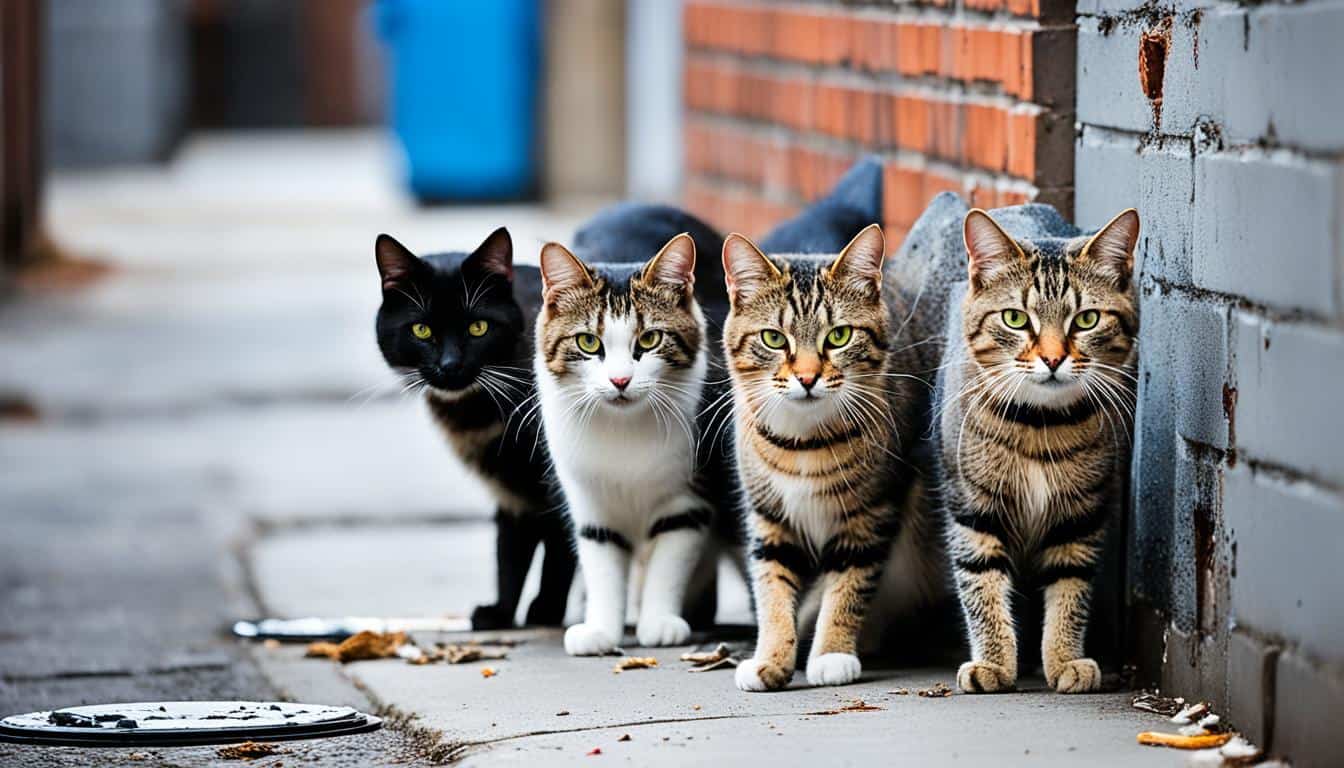Many see feral cats as innocent stray animals. Yet, they play a big role in disrupting ecosystems in the United States. This has caused a debate. Some believe we should protect feral cats. Others point out these cats pose dangers to local wildlife.
Research shows feral cats are causing harm in the USA. For example, in Texas, they’ve contributed to the drop in rabbit numbers. A 2019 study found feral cats in both cities and the countryside. They harm native species and disrupt natural services, like insect control and pollination. Feral cats have even helped cause the extinction of 63 species since 1500. They still threaten endangered animals today.
Understanding Feral Cats
Feral cats are once-domestic cats that now live in the wild on their own. They are different from stray cats, which have had homes but got lost or were left behind. These cats like to be unseen and do not get too close to people. They live on their own and act like the top animals in their area.
Definition and Distinction from Stray Cats
Feral cats are good at living outside without help from people. They grow up in the wild or go back to being wild after being pets. Most feral cats do not want anything to do with humans and might even act scared or mean if people get too close.
Behavior and Adaptation to Human Environments
The behavior of wild feral cats shows how they have learned to live in the wild together. They sometimes take care of each other’s kittens in groups. This is common in places like farms where groups of feral cats live.
Feral cats are very skilled at finding their own food and surviving tough times. They claim areas for themselves and can be very fierce if someone or something threatens them. This shows how strong they are in finding ways to live, unlike stray cats who depend on people more.
Are there any wild feral cats in the USA?
Feral cats are a big issue in the U.S., with about 70 million out there. This shows feral cats pose a major problem. They come from abandoned or lost pets and their wild-born offspring. This leads to their large numbers continuing to grow.
Population Estimates Across the Country
The number of feral cats is a huge concern. It shows how widespread the issue is. They live in cities and the countryside, surviving well in all places. This makes controlling their numbers very difficult.
Regional Variations and Hotspots
Looking closer, we find some areas in the U.S. where feral cats are more common. These hotspots show how well feral cats adapt. They live in big cities and quiet natural places alike.
Knowing about these regional differences is key. It helps us plan better ways to control feral cat numbers. And, it’s important for protecting local wildlife from their impact.
The Role of Feral Cats in Urban and Rural Settings
Feral cats live in cities and the countryside all over the USA. Each place has different effects and problems because of these cats. They are known as either urban feral cats or rural wild cats America. Their presence can change the area they live in.
Urban Impacts on Local Fauna
In cities, feral cats can harm the local wildlife. They lower the numbers of birds, small mammals, and even some game species. Because there are so many of them in cities, they can really affect the animals around, which is bad news for the ecosystem.
Rural Challenges and Benefits
Out in the country, there are challenges with these cats, but there are also some good things. Even though they may hunt native wildlife, these cats can help control rats and mice on farms. This is a big plus for farmers, as it offers a way to manage pests without chemicals.
It’s clear that feral cats play different roles depending on their location. Figuring out how to deal with them effectively means understanding their effect on both city and country life.
| Urban Feral Cats | Rural Wild Cats America |
|---|---|
| Impact bird and small mammal populations | Predation on native wildlife |
| Contribute to ecological shifts in cities | Benefit of reducing rodent populations |
| Higher density in urban areas | Presence in agricultural environments |
The Environmental Impact of Feral Cats on Native Wildlife
Feral cats have a big effect on the environment. They hunt and kill billions of birds, mammals, and reptiles each year in America. This hunting disrupts the balance of ecosystems and hurts many species and their homes.
Predation on Birds, Mammals, and Reptiles
The main way feral cats harm the environment is by hunting native animals. In the U.S., they kill billions of birds, mammals, and reptiles annually. Take for example a study from the Smithsonian Conservation Biology Institute. It shows cats kill about 2.4 billion birds and 12.3 billion mammals yearly.
Case Studies of Ecosystem Disruption
Looking at specific cases, we see just how much feral cats can disrupt an ecosystem. For example, bobwhite quail are seeing their numbers drop where feral cats roam a lot. Across areas where feral cats are a problem, the quail population has decreased notably because of cat predation. It’s a clear sign that feral cats can throw local ecosystems off-balance in ways that have big effects.
Impact on Endangered Species
Feral cats are a serious issue for already endangered species, like the Piping plover and the Florida scrub jay. These rare birds are losing numbers because of cat predation. Sadly, efforts to save these at-risk birds are struggling because of feral cats’ invasion.
| Species | Impact | Population Decline |
|---|---|---|
| Piping Plover | Predation by feral cats | Significant |
| Florida Scrub Jay | Predation by feral cats | Notable |
| Bobwhite Quail | Ecosystem disruption | Severe |
Population Control Methods and Their Efficacy
Keeping a check on feral cat numbers is vital for nature’s balance and animal welfare. The main way to control their numbers is through Trap-Neuter-Return (TNR). This method catches the cats, fixes them to stop breeding, and then puts them back in their area. We look at how well TNR works and other ways to manage feral cat numbers.
Trap-Neuter-Return (TNR) Programs
TNR aims to lower feral cat births, gradually reducing the cat population. It works by neutering cats and releasing them where they were found. Studies show TNR can lead to big drops in some places but not as much in others. This is because some cats keep having kittens and some are always being left alone by people.
Pros and Cons of TNR
There are several pluses to using TNR. It’s a kind way to cut down on feral cats and it helps animal shelters that would otherwise be overfull. TNR also makes feral cat groups more stable and less harmful to the local wildlife. And, it often gets support from the community.
However, TNR might not work the same everywhere. It faces problems like needing a lot of time and money, and dealing with the multiple births of new kittens. So, when a place wants to use TNR, they must think about these good and bad points.
Alternative Population Control Strategies
Besides TNR, there are other ways to handle the feral cat problem. Some other ways include:
- Education: Teaching people to be responsible with their pets can lessen the number of feral cats.
- Rehoming: Trying to find homes for these cats through adoption can help.
- Euthanasia: In the worst cases, putting these cats down might be considered to stop overpopulation.
- Legislation: Making laws about how to care for pets and making sure they’re fixed can also help.
Each of these ways has its pluses and minuses. To really make a difference in feral cat numbers and their effect on the environment, a mix of strategies can be the best approach.
| Method | Pros | Cons |
|---|---|---|
| Trap-Neuter-Return (TNR) | Humane, community-supported, stabilizes colonies | Resource-intensive, variable efficacy |
| Education | Long-term prevention, decreases abandonment | Requires widespread implementation and awareness |
| Rehoming | Reduces feral population, saves lives | Limited capacity, requires strong adoption network |
| Euthanasia | Immediate reduction | Highly controversial, ethical concerns |
| Legislation | Promotes responsible ownership | Enforcement can be challenging |
Public Health Concerns Related to Feral Cats
Feral cats are a big worry for public health because they spread sickness to people and other animals. This risk is significant for both humans and the animals in the wild.
Toxoplasmosis and its Implications
Toxoplasmosis is a serious disease that feral cats can spread to people. The germ that causes it, Toxoplasma gondii, infects many types of animals, including us. When people touch or breathe in the germs from cat poop, they can get sick. Pregnant women should be especially careful because the disease might harm their babies.
Other Zoonotic Diseases
Besides Toxoplasmosis, feral cats can carry other illnesses that can jump to us. These include rabies, cat scratch disease, and stomach worms and parasites. The risk of these sicknesses from feral cats is a major concern for public health.
Mitigation and Safety Measures
We can lessen the danger of getting sick by following simple yet important rules. Keeping pet cats inside, up-to-date on shots, and free from worms is key. Also, teaching people about how to properly care for their pets helps tackle the problem at its root.
Debates and Controversies Surrounding Feral Cats
The topic of feral cats is often debated. This happens mainly between two groups: conservationists and animal rights advocates. Both groups discuss the problem of managing feral cats well for the ecosystem and the cats’ well-being.
Conservationists’ vs Animal Rights Advocates
Conservationists are worried about what feral cats do to the environment. They believe feral cats harm local species and their habitats. They are concerned that feral cats might lead to the extinction of some creatures. However, animal rights advocates argue for the cats’ well-being. They believe feral cats should be protected and treated kindly like all animals.
Legal and Ethical Considerations
Legal issues and ethical concerns make the debate more complex. People suggest different solutions, from TNR programs to euthanasia. These choices make us ask tough questions about the rights of feral cats and protecting other animals. Finding the right solution means looking at how it affects the environment, the effectiveness, and our moral duty to all creatures.
Historical Context: How Feral Cats Became So Numerous
The surge of feral cats in the U.S. links back to the nation’s history and how people settled. Settlers carried domestic cats with them to catch pests. These cats later found their freedom, increasing the number of strays across the country.
Introduction Through Human Settlements
European colonists first brought cats to North America. Cats quickly found their place, helping in both cities and the countryside. Though cats were valued for rodent control, not all chose to stay with humans. Those that left started the feral cat populations the U.S. faces today.
Reproduction Rates and Survival Challenges
Feral cats are known for breeding fast, with females having many litters a year. Their overpopulation is a big issue in the U.S. An average feral cat has about 1.6 litters every year, each with multiple kittens. Despite diseases, predators, and tough weather, these cats find ways to survive and increase their numbers.
Case Studies of Feral Cat Management in the USA
In the USA, states are trying different ways to control feral cats. Florida and North Carolina are leading in this effort. By studying their methods, we learn what works and the challenges.

Success Stories and Lessons Learned
In Florida, they have made great progress with feral cats. They’ve used a method called Trap-Neuter-Return (TNR). This involves the community in taking care of these cats. Local people look after the cats and make sure they get medical help. This approach also considers the impact of feral cats on local wildlife.
- Community Involvement: Engaging local residents to take part in TNR programs.
- Healthcare: Ensuring consistent medical check-ups for managed colonies.
- Collaboration: Partnering with wildlife groups for a balanced approach.
Failures and Areas for Improvement
Despite some wins, controlling feral cat numbers remains hard. In North Carolina, TNR programs often feel the pressure due to too many kittens. It’s tough when there’s not enough money and people to help.
| State | Program | Challenges |
|---|---|---|
| Florida | Community-based TNR | Requires ongoing community engagement |
| North Carolina | TNR Programs | High reproduction rates, insufficient funding |
What Can You Do to Help Address the Feral Cat Problem?
Dealing with feral cats means we all need to help. You can start by supporting Trap-Neuter-Return (TNR) efforts. These programs catch feral cats, fix them, and then put them back where they were found. By giving time or money to TNR, you make a big difference.
It’s also key to teach people about caring for pets. Make sure folks know why it’s vital to fix their animals. This stops more feral cats from showing up. Talking about what it means to be a good pet owner can help, too. It lessens the chance of pet owners just leaving their animals behind.
Joining in at local shelters is another way to do your part. They do a lot for the cat community, like fixing cats and finding them good homes. You can help with TNR, care for cats, and spread the word. Your work makes the area better for everyone, cats included.
FAQ
Are there any wild feral cats in the USA?
Yes, the USA has many wild feral cats. They live outside, in both cities and the countryside. These cats affect local wildlife because they hunt.
What is the difference between feral cats and stray cats?
Feral cats are wild and don’t like being near people. They live outside on their own. Stray cats, however, might let people get close and look for humans for food or a safe place.
How many feral cats are estimated to be in the USA?
There could be around 70 million feral cats in the USA. This number changes with local conditions and how these cats are managed.
Are there regional variations and hotspots for feral cat populations in the USA?
Yes, the number of feral cats in different places varies. Some areas have more cats. This can be because of the weather, how many people live there, and the local animals.
What impact do feral cats have in urban settings?
In cities, feral cats can hurt bird and small mammal populations. They can be a problem for the environment. But, they also help by keeping down the number of city rats.
What challenges do feral cats pose in rural areas?
In the countryside, feral cats hunt local wildlife. This can affect the local ecosystem. But, they also help farmers by catching rodent pests.
How do feral cats affect native wildlife?
Feral cats hunt and catch native animals. This can damage the local environment. They can even hurt animals that are in danger of disappearing forever.
Can you provide examples of ecosystem disruption by feral cats?
For example, feral cats have badly affected bobwhite quail. They’ve also hurt other species, like Piping plover and Florida scrub jay.
What are the pros and cons of Trap-Neuter-Return (TNR) programs for feral cats?
TNR tries to control the number of feral cats by spaying and neutering them. It has good points and bad points. Good things are fewer cats and happier, healthier cats. Bad things are too many cats still being born.
What other population control strategies exist for feral cats?
Other ways to control feral cats include teaching people, finding them homes, putting them to sleep, and passing laws to stop people from letting their cats go.
What public health concerns are associated with feral cats?
They can pass diseases to people and other animals. Diseases like Toxoplasmosis can be dangerous, especially to pregnant women.
How can public health risks from feral cats be mitigated?
We can make things better by being clean and smart about pets. It’s important to know about diseases and to help control the cat population.
What are the main points of debate regarding feral cats?
People argue about the harm feral cats do and what to do about them. Some want to protect wildlife. Others want to help the cats in kind ways.
How did feral cats become so numerous in the USA?
Feral cats and people have grown up together. Cats have lots of kittens, and they have learned how to live free, even when the world is tough.
What are some success stories in managing feral cat populations?
Places like Florida and North Carolina have done well with TNR. They show what we can do to get better at helping feral cats.
What can you do to help address the feral cat problem?
You can help by supporting TNR and talking to people about taking good care of pets. You can also work to make sure there are right laws to keep pets safe. And, helping out at animal shelters can make a big difference for cats.







